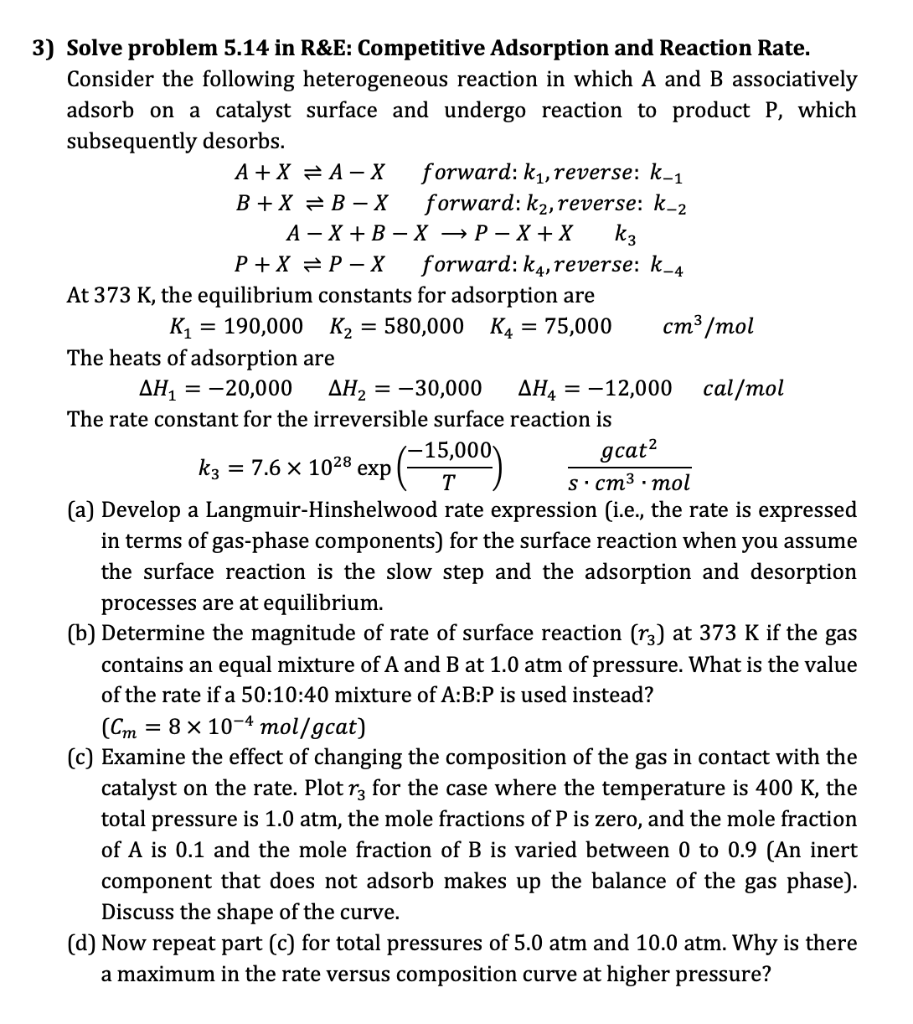
3) Solve problem 5.14 in R&E: Competitive Adsorption and Reaction Rate. Consider the following heterogeneous reaction in which A and B associatively adsorb on a catalyst surface and undergo reaction to product P, which subsequently desorbs. A +X = A-X forward: k1, reverse: k-1 B +X = B - X forward: k2, reverse: k-2 A - X + B - X P-X+X kz P +X = P-X forward: k, reverse: k-4 At 373 K, the equilibrium constants for adsorption are K1 = 190,000 K2 = 580,000 K4 = 75,000 cm3 /mol The heats of adsorption are AH, = -20,000 AH2 = -30,000 AH4 = -12,000 cal/mol The rate constant for the irreversible surface reaction is 1-15,000 gcat? k3 = 7.6 x 1028 exp T s.cm3 . mol (a) Develop a Langmuir-Hinshelwood rate expression (i.e., the rate is expressed in terms of gas-phase components) for the surface reaction when you assume the surface reaction is the slow step and the adsorption and desorption processes are at equilibrium. (b) Determine the magnitude of rate of surface reaction (r3) at 373 K if the gas contains an equal mixture of A and B at 1.0 atm of pressure. What is the value of the rate if a 50:10:40 mixture of A:B:P is used instead? (Cm = 8 x 10-4 mol/gcat) (C) Examine the effect of changing the composition of the gas in contact with the catalyst on the rate. Plot rz for the case where the temperature is 400 K, the total pressure is 1.0 atm, the mole fractions of P is zero, and the mole fraction of A is 0.1 and the mole fraction of B is varied between 0 to 0.9 (An inert component that does not adsorb makes up the balance of the gas phase). Discuss the shape of the curve. (d) Now repeat part (c) for total pressures of 5.0 atm and 10.0 atm. Why is there a maximum in the rate versus composition curve at higher pressure? 3) Solve problem 5.14 in R&E: Competitive Adsorption and Reaction Rate. Consider the following heterogeneous reaction in which A and B associatively adsorb on a catalyst surface and undergo reaction to product P, which subsequently desorbs. A +X = A-X forward: k1, reverse: k-1 B +X = B - X forward: k2, reverse: k-2 A - X + B - X P-X+X kz P +X = P-X forward: k, reverse: k-4 At 373 K, the equilibrium constants for adsorption are K1 = 190,000 K2 = 580,000 K4 = 75,000 cm3 /mol The heats of adsorption are AH, = -20,000 AH2 = -30,000 AH4 = -12,000 cal/mol The rate constant for the irreversible surface reaction is 1-15,000 gcat? k3 = 7.6 x 1028 exp T s.cm3 . mol (a) Develop a Langmuir-Hinshelwood rate expression (i.e., the rate is expressed in terms of gas-phase components) for the surface reaction when you assume the surface reaction is the slow step and the adsorption and desorption processes are at equilibrium. (b) Determine the magnitude of rate of surface reaction (r3) at 373 K if the gas contains an equal mixture of A and B at 1.0 atm of pressure. What is the value of the rate if a 50:10:40 mixture of A:B:P is used instead? (Cm = 8 x 10-4 mol/gcat) (C) Examine the effect of changing the composition of the gas in contact with the catalyst on the rate. Plot rz for the case where the temperature is 400 K, the total pressure is 1.0 atm, the mole fractions of P is zero, and the mole fraction of A is 0.1 and the mole fraction of B is varied between 0 to 0.9 (An inert component that does not adsorb makes up the balance of the gas phase). Discuss the shape of the curve. (d) Now repeat part (c) for total pressures of 5.0 atm and 10.0 atm. Why is there a maximum in the rate versus composition curve at higher pressure







